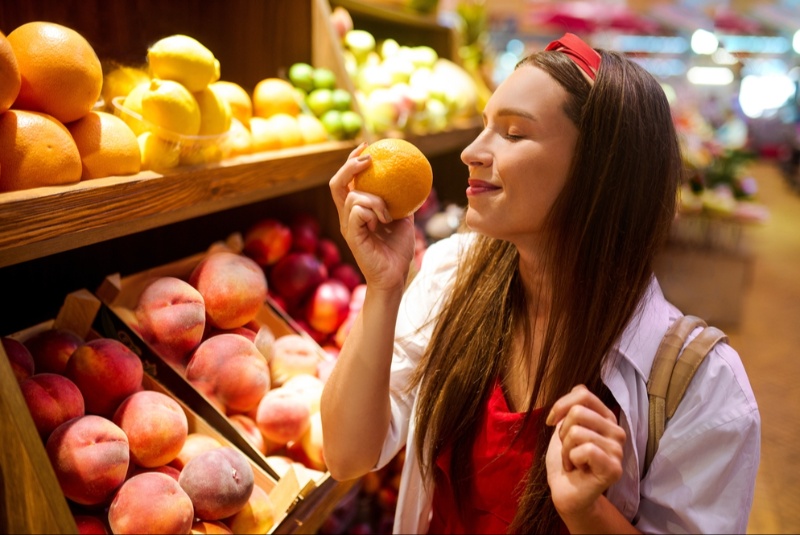Embark on a flavorful journey with these essential tips on selecting the freshest fruits. From juicy berries to crisp apples, this comprehensive guide empowers you to make informed choices in the produce aisle, ensuring that each bite is a burst of natural sweetness and vitality.
1. The Look of Freshness: Assessing Visual Indicators
Vibrant Colors and Skin Texture
Train your eyes to spot vibrant colors and smooth skin textures. Fresh fruits exhibit a lively, saturated color indicative of their ripeness. Whether it's the deep red of strawberries or the golden hue of a ripe pineapple, opt for fruits with consistent color and a skin free of wrinkles or blemishes.
Natural Sheen and Gloss
Look for a natural sheen or gloss on the surface. Many fruits, like cherries or grapes, have a natural shine when they're at their freshest. This sheen indicates optimal moisture content, ensuring a juicy and flavorful eating experience.
2. Feel the Freshness: Gauging Texture and Firmness
Firmness and Resilience
Master the art of feeling for firmness and resilience. Gently squeeze or press different parts of the fruit to assess its overall texture. Fresh fruits should yield slightly to pressure without feeling overly soft. Firmness is a key indicator of ripeness.
Uniform Firmness Across the Fruit
Ensure uniform firmness across the entire fruit. Inconsistencies in firmness may suggest uneven ripening or areas of decay. A uniformly firm texture guarantees that the fruit is ready to be enjoyed and hasn't experienced premature softening.
3. The Fragrance Test: Smelling for Ripeness
Distinctive Aromas
Engage your sense of smell with the fragrance test. Fresh fruits emit distinct aromas when ripe. Take a moment to smell the stem end of fruits like melons or peaches, and choose those with a sweet, fruity fragrance. Fruits that lack a noticeable aroma may need additional time to ripen.
Avoiding Off-Putting Odors
Stay vigilant for off-putting odors. Unpleasant smells can be a sign of overripeness or decay. Fruits like berries or citrus should have a fresh, slightly sweet scent. Any sour or fermented odors may indicate spoilage.

4. Seasonal Savor: Embracing Fruits in Their Prime
Understanding Seasonal Availability
Embrace seasonal availability for optimal freshness. Different fruits have peak seasons when they are at their ripest and most flavorful. Familiarize yourself with the seasons of your favorite fruits, and capitalize on their freshness during the right time of the year.
Exploring Local and Farmer's Markets
Explore local and farmer's markets for seasonal treasures. Locally sourced fruits often have a shorter time between harvest and sale, guaranteeing superior flavor and nutritional content. Farmer's markets are excellent places to discover unique and freshly harvested fruits.
5. Size and Shape Matters: Choosing Consistency
Uniform Size and Shape
Opt for fruits with uniform size and shape. Consistency in these aspects often indicates even ripening and quality. Misshapen or irregularly sized fruits may have experienced uneven growing conditions, potentially affecting taste and texture.
Checking for Plumpness
Check for plumpness in fruits like berries or grapes. Plump, well-rounded fruits are generally juicier and more flavorful. Conversely, flat or deflated fruits may be dehydrated and lacking in the delicious juices you seek.
6. Examining Leaves and Stems: Signs of Freshness
Lush and Vibrant Leaves
Examine the leaves or stems of fruits sold with attached foliage. Fresh fruits, especially berries or pineapples, should have lush and vibrant leaves. Wilted or discolored leaves may indicate the fruit is past its prime.
Healthy, Moist Stems
Inspect the stems, particularly for berries. Healthy stems are moist and firmly attached to the fruit. Dry or withered stems suggest dehydration, potentially affecting the overall freshness of the fruit.
7. Organic Choices: A Mindful Approach to Freshness
Prioritizing Organic Options
Consider prioritizing organic options for a mindful approach. While not a necessity, choosing organic fruits can reduce exposure to pesticides and support sustainable farming practices. Understand the principles of organic farming to make choices aligned with your preferences.
Rinsing or Washing Organic Fruits
If choosing organic, rinse or wash the fruits thoroughly. While organic fruits may have fewer pesticide residues, it's still essential to practice proper hygiene by washing them before consumption.
Elevate Your Taste Buds with Fresh and Juicy Delights
The pursuit of fresh and flavorful fruits is an art that enhances not only your culinary experiences but also your overall well-being. Armed with these tips, you're now equipped to navigate the produce aisle with confidence, selecting fruits that promise a burst of natural sweetness and nutritional vitality. Elevate your taste buds with every juicy bite, celebrating the vibrant, delicious world of fresh fruits.




